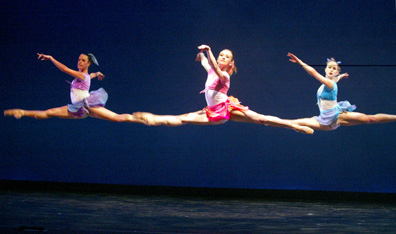Kitsch With Airs
Tango
Palace/No Viviré/Penny Lane/Les Noces/Come Dance Me a Song
Smuin Ballet
The Joyce Theater
New York, NY
August 19, 2004
By
Leigh Witchel
copyright
© 2004 by Leigh Witchelr
published August 23, 2004
One Marilyn Monroe impersonator per ballet isn’t enough for Michael Smuin. He needed two for “Come Dance Me a Song”. The problem with his choreography in a nutshell is one Marilyn Monroe impersonator in a ballet is bad, two is worse, but twelve might just have worked.
 Mr.
Smuin’s company came from San Francisco to New York again for a
week at the Joyce bringing a raft load of kitsch with them, but it’s
cautious kitsch that wishes it were respectable; plastic slipcovers on
Herculon sofas instead of a yard crammed full of pink plastic flamingoes.
“Come Dance Me a Song”, to music by Elton John (Sir Elton
John, this is respectable kitsch) uses piano transcriptions that append
Bach inventions to his songs. Pity the poor kitsch that wishes it were
Bach. Along with the Monroe number there’s a maudlin father-with-son-dying-of-AIDS
dance that oscillates between pathetic and offensive. Tragedy comes cheap
when it’s kitsch tragedy.
Mr.
Smuin’s company came from San Francisco to New York again for a
week at the Joyce bringing a raft load of kitsch with them, but it’s
cautious kitsch that wishes it were respectable; plastic slipcovers on
Herculon sofas instead of a yard crammed full of pink plastic flamingoes.
“Come Dance Me a Song”, to music by Elton John (Sir Elton
John, this is respectable kitsch) uses piano transcriptions that append
Bach inventions to his songs. Pity the poor kitsch that wishes it were
Bach. Along with the Monroe number there’s a maudlin father-with-son-dying-of-AIDS
dance that oscillates between pathetic and offensive. Tragedy comes cheap
when it’s kitsch tragedy.
“Les Noces” is the plastic slipcover to the evening, the bid at respectability. There are only a few deeply egregious moments in it; it seems in this version that what the bride and groom want to do is boff, and the parents have to keep pulling them off of each other. At the climactic moment in Stravinsky’s score when the pianos peal in imitation of church bells the groom (David Strobbe) reaches under the skirt of the bride (Vanessa Thiessen) and lifts her by the crotch. However, the main flaw of the work is that Mr. Smuin tries to personalize Stravinsky’s awe-inspiring, impersonal score and give all the characters individuality. He even prefaces the score with a recorded tape of what sounds like real people at the banquet of a real Russian wedding. Besides trivializing the music, it can’t work; “Les Noces” is not about “this bride” and “this groom”; it’s about “The Bride” and “The Groom”. Rituals don’t focus on individual personalities. Mr. Smuin references Nijinska’s brilliant choreography for the initial production at least twice; once in the crouched jumps at the end of the second tableau, and then in the totem pole of women’s faces that he places in the final tableau. Unfortunately, if you know the Nijinska, you’re only reminded of what you’re not seeing.
The first dance of the evening, “Tango Palace” takes a tired formula (tangos, chairs, a smoky room and elegant evening wear) and never departs from it. Mr. Smuin does have a personable and committed group of dancers to work with. Ms. Thiessen danced “No Viviré”, a solo to a song by The Gipsy Kings. She performed with technical assurance, as if the solo weren’t as musically obvious, with jumps and kicks on every boom and crash, as a number from the talent competition at a regional beauty pageant. Mr. Smuin handles vocabulary and dancers with facility and craft, but falters badly on architecture and the big picture. His dances don’t add up in dance terms or as ideas; he can end a tango ballet with a song by Edith Piaf and never ask himself if that makes sense.
It seems churlish not to like Mr. Smuin’s work, you can tell that what he wants most is for the audience to have a great time. His instincts work best on a revue level; the two tap numbers in the evening had charm. When he starts doing Vegas-style tricks (disembodied hands clapping to the beat at the wings or a stage full of dancers in sparkly red shoes) the kitsch is amiable. Mr. Smuin has plenty of experience with commercial work; he won a Tony award for his solid work in “Anything Goes”. Musical theater has almost lost its ballet tradition; choreographers like him could help to reawaken it. Broadway is also the right milieu for kitsch with airs. Plastic slipcovers don’t work in concert dance. Either give us a Chippendale sofa or have the courage to be the spark that ignites a million Lava Lamps.
Photo: Smuin Ballet in Michael Smuin's Elton John inspired “COME DANCE ME A SONG”. (l-r) Amy Seiwert, Galina Alexandrova, Sarah Barber Wilson. Photo by Tom Hauck
Originally
published:
www.danceviewtimes.com
Volume 2, No. 32
August 23, 2004
Copyright
©2004 by Leigh Witchel
|
|
|